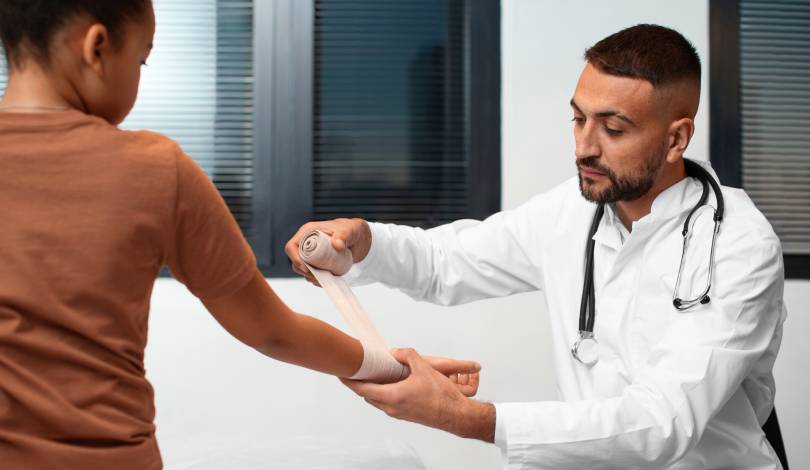Synopsis
Elbow pain can severely impact your ability to perform basic activities like lifting, writing, typing, or even holding a cup. Whether it stems from sports injuries like tennis or golfer’s elbow, or from fractures and strain, elbow physiotherapy provides safe and effective relief. This blog explores how physiotherapy for tennis elbow, physio for fractured elbow, and physical therapy for elbow pain helps address inflammation, restore joint function, and prevent recurrence. We’ll also dive into the best approaches for golfers elbow physiotherapy and physio for elbow stiffness—conditions that often go untreated for too long. With the help of expert guidance, physical therapy for tendonitis elbow and elbow bursitis reduces pain and improves strength. Whether you’re searching for long-term relief or recovering from a broken elbow, this guide will help you understand how elbow physiotherapy can put you back on track—pain-free and confident.
Table of Contents
- Common Causes of Elbow Pain
- Understanding Tennis and Golfer’s Elbow
- How Physiotherapy for Tennis Elbow Works
- Recovery After Fracture: Physio for Fractured Elbow
- Managing Chronic Pain: Golfer’s Elbow Physiotherapy
- Techniques in Physical Therapy for Tendonitis Elbow
- Stiff Elbow? Here's How Physiotherapy Helps
- Why Orthocure is the Right Choice for Elbow Physiotherapy
Common Causes of Elbow Pain
Elbow pain can result from repetitive strain, trauma, arthritis, or nerve entrapment. It often affects those involved in sports, manual labour, or long periods of typing and mouse use. Conditions such as lateral epicondylitis (tennis elbow) and medial epicondylitis (golfer’s elbow) are the most common. Physiotherapy for tennis elbow and other conditions addresses both inflammation and biomechanical imbalances. Ignoring early symptoms may lead to persistent stiffness, weakness, or even reduced grip strength.
Understanding Tennis and Golfer’s Elbow
Tennis elbow involves inflammation of the tendons on the outer part of the elbow, while golfer’s elbow affects the inner tendons. Both result in pain, tenderness, and weakness. These overuse injuries are common in athletes, office workers, and anyone performing repetitive wrist movements. Physiotherapy for tennis elbow and golfers elbow physiotherapy uses a combination of manual therapy, tendon loading exercises, and muscle activation to ease pain and restore function.
How Physiotherapy for Tennis Elbow Works
Physiotherapy for tennis elbow includes soft tissue mobilisation, eccentric strengthening, and wrist extensor training. The goal is to reduce tendon overload and promote healing. Taping, dry needling, and ultrasound therapy may be used to relieve pain. Patient education on movement modification and workplace ergonomics also plays a vital role. Treatment helps prevent recurrence and allows patients to resume normal activities without discomfort.
Recovery After Fracture: Physio for Fractured Elbow
A fractured elbow requires structured rehabilitation to avoid long-term stiffness and weakness. Physio for fractured elbow begins post-immobilisation with range-of-motion exercises. As healing progresses, resistance exercises and functional training are introduced. Physical therapy for elbow pain following fractures focuses on restoring extension, flexion, and rotational control. It ensures that joints regain their natural mechanics, enabling full arm use in daily tasks.
Managing Chronic Pain: Golfer’s Elbow Physiotherapy
Golfer’s elbow physiotherapy focuses on improving flexibility, correcting movement patterns, and strengthening the flexor muscles. Manual therapy, heat modalities, and progressive loading exercises reduce tendon irritation. Therapists also assess shoulder and wrist mechanics to identify compensatory patterns. With consistent therapy, symptoms diminish and strength improves. The result is a more stable and pain-free elbow that can endure repetitive motions without strain.
Techniques in Physical Therapy for Tendonitis Elbow
Physical therapy for tendonitis elbow involves reducing inflammation, reactivating muscle fibres, and restoring tendon elasticity. Treatment includes soft tissue mobilisation, resistance band exercises, and forearm strengthening. Neuromuscular re-education and proprioception drills are also added to retrain the arm’s movement coordination. This comprehensive approach accelerates tendon recovery and prevents deterioration. With proper follow-up, chronic tendonitis can be successfully managed through physiotherapy.
Stiff Elbow? Here's How Physiotherapy Helps
Physio for elbow stiffness is essential after injuries, surgeries, or prolonged immobility. Therapy includes joint mobilisation, active-assisted movements, and soft tissue release. Stretching techniques improve flexibility, while muscle activation exercises promote circulation and healing. Heat therapy and manual mobilisation reduce tension in surrounding tissues. Over time, patients regain full range of motion and functional strength. Early physiotherapy is key to avoiding long-term limitations.
Why Orthocure is the Right Choice for Elbow Physiotherapy
Orthocure Clinics and Gyms offer a complete rehabilitation ecosystem under one roof. Their 4 Point Protocol—Diagnosis, Pain Relief, Structural Correction, and Maintenance—ensures that patients receive holistic care. From tennis elbow to post-fracture elbow stiffness, their physiotherapists personalise each program for maximum effectiveness. Orthocure’s evidence-based methods, coupled with advanced equipment and orthopaedic support, make it the trusted choice for physical therapy for elbow pain and injury recovery.
FAQs
How does physiotherapy help with tennis elbow?
Physiotherapy reduces pain and inflammation while improving tendon health in tennis elbow. It includes stretching, eccentric loading, and manual therapy to restore flexibility and strength. Therapists also guide on activity modification and ergonomics. With consistent sessions, symptoms improve without the need for injections or surgery. Early intervention leads to quicker recovery and reduced recurrence.
When should I start physio for a fractured elbow?
You should begin physiotherapy after your orthopaedic specialist confirms bone healing. Early intervention focuses on mobility restoration and swelling reduction. Later stages include strengthening and coordination training. Delaying rehab may result in joint stiffness and limited arm function. A structured plan ensures full recovery and return to activity.
What is the difference between tennis elbow and golfer’s elbow physiotherapy?
Tennis elbow targets the outer elbow and extensor tendons, while golfer’s elbow affects the inner elbow and flexor tendons. Both involve pain from repetitive motion but differ in tendon location. Physiotherapy protocols vary in terms of muscle activation, stretch direction, and grip training. A therapist will assess the specific pattern and customise treatment accordingly.
How is physical therapy for tendonitis elbow structured?
Physical therapy for tendonitis elbow includes pain control, muscle reactivation, and gradual strengthening. It starts with rest and inflammation management, then transitions to tendon loading and functional exercises. Taping and electrotherapy may also be used. The program is progressive, adapting to patient response over time. The goal is complete pain resolution and return to function.
Can physiotherapy treat chronic elbow stiffness?
Yes, physiotherapy is highly effective in managing chronic elbow stiffness. Techniques such as joint mobilisation, soft tissue release, and active movement retraining are used. Regular stretching and strength exercises help restore flexibility and function. Therapy also corrects posture and compensatory habits. Early intervention yields better results and prevents long-term complications.





